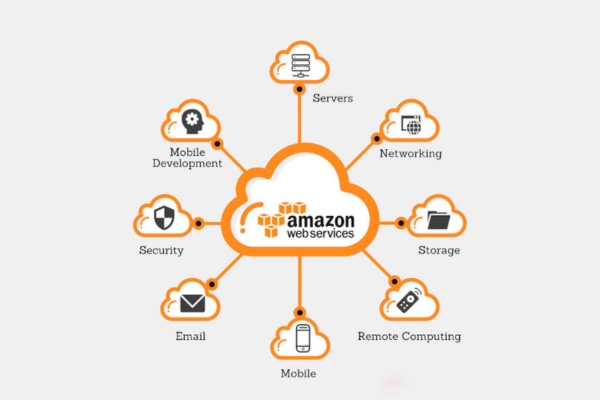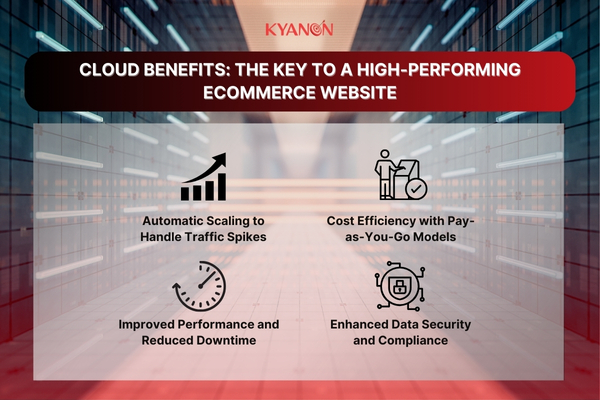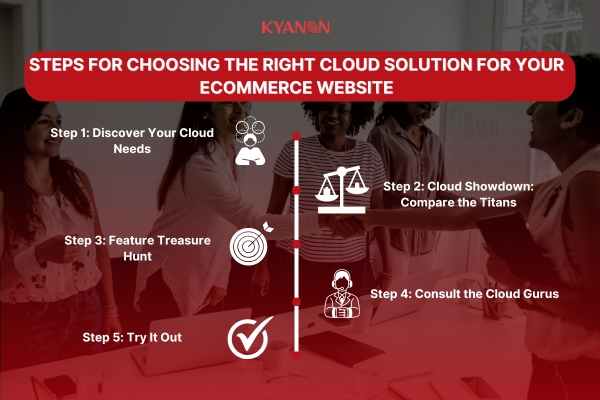An eCommerce website must grow quickly to keep up with customers’ ever-changing needs. Enter cloud computing—a powerful tool that is transforming how businesses scale. According to Gartner, global spending on cloud services is projected to soar to $600 billion by 2023. This trend shows just how vital cloud technology has become for businesses.

With cloud solutions, eCommerce websites can effortlessly adjust their resources to handle traffic surges, especially during major sales events like Black Friday. This flexibility allows businesses to create a seamless shopping experience, which keeps customers coming back for more.
Moreover, cloud computing cuts costs by reducing upfront investments and enabling businesses to pay only for the resources they actually use. As the eCommerce landscape continues to expand, embracing cloud technology is crucial for staying ahead of the competition. In this blog, we’ll dive into how cloud computing boosts eCommerce scalability, helping businesses thrive in a fast-paced digital world.
1. Why Use Cloud for Your Ecommerce Website?
Cloud computing means using the Internet to store and manage data and applications instead of local servers. For strong eCommerce websites, this technology allows businesses to access powerful resources without spending a lot on hardware.

As a leading global eCommerce platform, Amazon uses its Amazon Web Services (AWS) for cloud computing. Here are the key benefits:

- Global Reach: AWS manages data centers worldwide, enabling Amazon to serve millions of customers without lag.
- Dynamic Resource Allocation: During events like Prime Day, AWS allows Amazon to scale resources to meet high traffic demands instantly.
- Data Analytics: Amazon uses cloud computing to analyze customer behavior in real-time, enhancing personalization and inventory management.
Cloud computing is a game-changer for strong eCommerce websites. By offering flexibility, cost efficiency, and improved performance, it empowers businesses to adapt and thrive in an ever-changing digital landscape. As eCommerce continues to expand, leveraging cloud technology will be essential for staying competitive and meeting customer demands.
2. Cloud Benefits: The Key to a High-Performing Ecommerce Website

2.1. Automatic Scaling to Handle Traffic Spikes
Cloud computing helps eCommerce websites handle sudden increases in visitors easily. When a big sale or holiday hits, many shoppers flood the site at once. The cloud quickly adds more server power to keep everything running smoothly.
For instance, imagine an online store holding a special flash sale. As customers rush to grab deals, the cloud automatically boosts the website’s capacity. This means no slow loading times or crashes, keeping shoppers happy and ready to buy. Once the sale is over, the cloud scales back down, saving the business money. This flexibility ensures eCommerce websites can keep up with demand and make the most of busy shopping times!
2.2. Cost Efficiency with Pay-as-You-Go Models
One of the biggest advantages of cloud computing is how much money it can save. Normally, businesses need to spend a lot of money upfront to buy hardware and set up their servers, which can be tough for many eCommerce companies. But with cloud services, businesses only pay for what they actually use—just like paying for electricity or water.
This pay-as-you-go model helps smaller businesses compete without breaking the bank.
For instance, imagine a small online store that experiences a surge in orders during a holiday season. Instead of investing heavily in servers, they might only need for a short time, they can simply scale up their cloud resources when demand is high and scale back afterward. This flexibility allows them to save money and focus on growth without overspending. It’s a smart way to manage costs while still succeeding!
2.3. Improved Performance and Reduced Downtime
Cloud computing significantly enhances the performance of eCommerce websites. It uses advanced technology to ensure that websites load quickly and run smoothly, even when many people are visiting at once. This improvement keeps customers engaged and happy.
For example, think about an online store during a busy shopping season. If the website is slow or crashes, customers might get frustrated and leave. With cloud services, businesses can use Content Delivery Networks (CDNs) that store copies of the website in various locations. This helps deliver content to users faster, no matter where they are.
By reducing downtime and improving speed, cloud computing helps eCommerce websites provide a seamless shopping experience. Customers are more likely to complete their purchases, leading to higher sales and happier shoppers!
2.4. Enhanced Data Security and Compliance
One of the biggest worries for eCommerce websites is keeping customer information safe. Cloud computing boosts security measures, helping businesses protect sensitive data like credit card numbers and personal details.
Cloud providers invest heavily in advanced security technologies and practices. They often offer features like encryption, which scrambles data to keep it safe from hackers. They also maintain strict access controls, ensuring that only authorized personnel can access sensitive information.
Moreover, cloud services help businesses comply with important regulations, such as GDPR and PCI DSS. This compliance is crucial for building trust with customers, as they want to know their information is secure.
By using cloud computing, eCommerce websites can enhance their security and ensure they meet legal requirements, giving customers peace of mind while shopping. This increased trust can lead to more sales and loyal customers!
Transform your ideas into reality with our services. Get started today!
Our team will contact you within 24 hours.
3. How Cloud Solutions are Shaping the Future of Ecommerce WebsiteEcommerce Website Across Different Industries

Cloud computing is revolutionizing eCommerce across various sectors. Here’s a look at how different industries are harnessing its power:
- Fashion & Apparel
Example: Brands like Zara utilize cloud computing to enhance inventory management. By tracking stock levels in real time, they can quickly respond to trends, ensuring that popular items are always available.
- Technology & Gadgets
Example: Dell employs cloud solutions for faster product launches. By managing data from various locations, they streamline updates, allowing customers to access the latest gadgets swiftly.
- Food & Beverage
Example: Starbucks integrates cloud technology for its mobile ordering system. Analyzing customer data enables tailored promotions and recommendations, enhancing user satisfaction and boosting sales.
- Beauty & Cosmetics
Example: Sephora uses cloud-based AI to provide personalized recommendations. This data-driven approach helps customers discover products they love, significantly increasing sales potential.
- Health & Wellness
Example: Online pharmacies leverage cloud computing to manage prescriptions and customer records efficiently. This ensures quick service and secure handling of sensitive data, improving overall customer trust.
- Home Goods
Example: IKEA employs cloud solutions to enhance its online shopping experience. By analyzing customer preferences and inventory, IKEA can suggest related items and manage stock levels effectively.
- Automotive
Example: Car manufacturers like Ford use cloud technology for better customer engagement. By analyzing driving data and preferences, they offer personalized marketing and services, making the buying process smoother.
- Travel & Hospitality
Example: Airbnb relies on cloud computing to manage listings and customer interactions. This allows them to scale quickly, handle large amounts of data, and provide a seamless booking experience for users.
- Entertainment
Example: Netflix utilizes cloud technology for streaming services. By leveraging cloud infrastructure, they ensure smooth delivery of content to millions of viewers, even during peak times, enhancing user satisfaction.
- Education
Example: Online learning platforms like Coursera use cloud solutions to deliver courses globally. This flexibility enables them to reach a wider audience while maintaining a high-quality educational experience.
4. Choosing the Right Cloud Solution for Your eCommerce Website
Choosing the right cloud solution for your eCommerce website is an important step toward success. By understanding your needs, comparing options, checking features, consulting experts, and testing your setup, you can make a smart choice that helps your business grow and thrive.

Step 1: Discover Your Cloud Needs
Start by thinking about what your eCommerce business requires. Ask yourself:
- How much traffic do you expect? Consider busy seasons like holidays.
- How much data will you store? Think about your inventory and customer information.
- What security do you need? Customer data protection is vital.
Step 2: Cloud Showdown: Compare the Titans
Here’s a quick look at popular cloud providers for eCommerce:
- Amazon Web Services (AWS):
- Pros: Lots of features and can grow with your business.
- Cons: It might be complicated for beginners.
- Google Cloud:
- Pros: Great for data analysis and works well with Google tools.
- Cons: May not have as many eCommerce features.
- Microsoft Azure:
- Pros: Good for businesses using Microsoft products and has strong security.
- Cons: Pricing can be hard to understand.
Step 3: Feature Treasure Hunt
When comparing providers, focus on these key features:
- Scalability: Look for solutions that grow with you. Automatic scaling helps manage traffic spikes easily.
- Cost: Choose a pricing plan that fits your budget. Pay-as-you-go options help you avoid big upfront costs.
- Security: Make sure the provider offers solid security features, like data encryption and compliance with laws.
- Integration: Ensure the cloud solution works well with your current eCommerce systems. This keeps everything running smoothly.
Step 4: Consult the Cloud Gurus
Pro Tip: Consult a cloud expert to help you make the right choice. They can:
- Spot Common Mistakes: Experts know what to watch out for.
- Suggest Improvements: They can recommend the best setup for your needs.
Step 5: Try It Out
Once you choose a provider, start with a trial or pilot program. This lets you test the solution and tweak it as needed before going all in.
5. Common Challenges and Solutions in Scaling eCommerce via Cloud Computing
Scaling your eCommerce business through cloud computing can be incredibly rewarding, but it also comes with its share of challenges. Here’s a look at some common obstacles businesses face and how to tackle them effectively.
5.1. Data Migration Complexity
- Why It’s a Problem: Moving your data to the cloud can feel like a daunting task. You might worry about losing important information or encountering downtime during the transition.
- Solution: Embrace Migration Tools Leverage powerful migration tools offered by cloud providers like AWS and Azure. These platforms provide user-friendly tools designed to simplify the migration process. For instance, AWS offers the AWS Database Migration Service, which allows you to transfer data quickly and securely with minimal downtime. This way, you can ensure a smooth transition without compromising your data integrity.
5.2. Security Concerns
- Why It’s a Problem: With more data moving online, security is a top priority. Many eCommerce businesses fear that storing sensitive customer information in the cloud could lead to data breaches or compliance issues.
- Solution: Implement Cloud Security Best Practices To safeguard your data, adopt cloud security best practices. This includes:
- Data Encryption: Always encrypt sensitive data both at rest and in transit.
- Regular Security Audits: Conduct routine checks to identify vulnerabilities.
- Managed Security Services: Consider partnering with managed security service providers that specialize in cloud environments to ensure ongoing protection and compliance with regulations like GDPR.
According to a report by McKinsey, businesses that implement strong security measures can reduce the risk of breaches by up to 80%.
5.3. Cost Management
- Why It’s a Problem: While cloud computing offers cost savings, businesses often struggle to manage their cloud expenses effectively. Without proper oversight, costs can spiral out of control, especially during peak traffic periods.
- Solution: Cloud Cost Optimization Strategies Adopt cost optimization strategies to keep your cloud expenses in check. Here’s how:
- Set Budgets and Alerts: Use tools like AWS Budgets to set spending limits and receive alerts when nearing thresholds.
- Monitor Usage: Regularly analyze your cloud usage to identify areas where you can cut back, such as shutting down unused resources.
- Use Reserved Instances: For predictable workloads, consider purchasing reserved instances, which can save you up to 75% compared to on-demand pricing.
According to Flexera’s 2023 State of the Cloud Report, 60% of organizations identified cloud cost management as a top challenge, highlighting the need for effective strategies.
To Wrap Up
Cloud computing is transforming how eCommerce websites scale across industries. It allows businesses to automatically adjust resources during peak traffic, offers cost-effective pay-as-you-go models, boosts performance, and enhances data security. No matter your sector—fashion, technology, food and beverage, or more—cloud solutions help optimize operations and elevate customer experiences.
Ready to elevate your eCommerce game? At Kyanon Digital, we craft custom cloud solutions designed to supercharge your growth and streamline your online platform. Let’s explore how we can help you scale effortlessly and achieve outstanding results!
Don’t miss out on unlocking your business’s true potential! Reach out today for personalized cloud computing services that revolutionize your eCommerce scalability. Together, let’s embark on your exciting journey to eCommerce success!

















